Join the discussion on this paper page.



“There’s a connection between the shape of the ice shell and the temperature in the ocean,” said Dr. Britney Schmidt. “This is a new way to get more insight from ice shell measurements that we hope to be able to get for Europa and other worlds.”
While Earth remains the only known world with bodies of liquid water on its surface, there are a myriad of worlds within our own solar system that have liquid water oceans beneath thick surfaces of ice. But what is the temperature of those interior oceans, and could the thickness of its ice shell determine it? This is what a recent study published in Journal of Geophysical Research Planets hopes to address as a team of researchers led by Cornell University investigated how a process called “ice pumping” could determine the temperature of the interior ocean underneath thick icy shells, also known as ice-ocean interaction. This study holds the potential to help researchers better understand the conditions for finding life beyond Earth with a focus on Jupiter’s moon, Europa, and Saturn’s moon, Enceladus.
“If we can measure the thickness variation across these ice shells, then we’re able to get temperature constraints on the oceans, which there’s really no other way yet to do without drilling into them,” said Dr. Britney Schmidt, who is an Associate Professor of Astronomy & Earth and Atmospheric Sciences at Cornell University and a co-author on the study. “This gives us another tool for trying to figure out how these oceans work. And the big question is, are things living there, or could they?”
For the study, the researchers used robotic observations obtained at Antarctica’s Ross Ice Shelf and computer models to analyze how “ice pumping”, which occurs in water underneath ice sheets and based on an ice shell’s slope, could help regulate ocean temperature when accounting for pressure and salt content, as well. The goal was to ascertain the potential behavior of ice-ocean interaction on Jupiter’s moon, Europa, and Saturn’s moon, Enceladus, both of which possess interior oceans and are targets for astrobiologists searching for life beyond Earth.

Young urban air mobility (UAM) developer Doroni Aerospace is stepping out of the shadows and into the eVTOL startup with the official reveal of its flagship aircraft – the H1-X. The two-seat eVTOL was showcased during a livestream event today and is damn close to being market-ready, touting some impressive specs.
Doroni Aerospace was founded in 2016 by Doron Merdinger – a lifelong entrepreneur with 25 years of design, manufacturing, and firm management expertise.
To bring his dreams of sustainable aviation transportation to life, Merdinger assembled a team of engineers and technicians working together to democratize flight in a growing eVTOL segment.

Electric vehicles’ price and driving range are probably the two most important factors for most buyers. In today’s post, we will look at the mix of the two parameters—the price per mile of the EPA Combined range.
That may sound complex, but it’s merely a metric that indicates the best value proposition overall, and something that gives us an idea of the “cost” of range. By checking this metric, we can also see whether there is progress over time compared to earlier reports: see February 2022, February 2021 or April 2020. As it turns out, progress is happening on this front, and the cost of the driving range is going down.
Before we jump into details, let’s just explain the basics. There are more than 300 individual EV configurations on sale, including different battery sizes, ranges, powertrain setups, and wheels—all of which directly affect the price and range. We collected numbers for about 300 configurations, that are currently available for order or reservation, some upcoming models, and a few that have been discontinued but may still be found on dealer lots as reference points.

While I believe Tesla’s move to open its Supercharger network to other automakers is ultimately going to have a great impact on EV adoption, it is also a smart business move from Tesla.
Here’s the business behind Tesla opening its Supercharger network.
Tesla, to no fault of its own, has been using its Supercharger network as a moat in the North American EV market.




Inside her small office, with a window overlooking the iconic Kerckhoff Hall student centre at University of California, Los Angeles (UCLA), chemical biologist Mireille Kamariza is pursuing her big dream. Since 2015, she has steadily worked to stop transmission of deadly tuberculosis (TB) superbugs, which in 2022 infected more than 10 million people and killed more than one million.
As a PhD student working with Nobel laureate Carolyn Bertozzi, now a chemist at Stanford University in California, she developed a fluorescent diagnostic test that could be used for quick detection of TB, especially in resource-poor settings. In 2019, alongside Bertozzi, Kamariza founded the biotech start-up company OliLux Biosciences, based in Los Angeles, to develop reliable tools for detecting TB that are tailored to the complex needs of poorer countries. Nature sat down with Kamariza to talk about her progress in testing these diagnostic tools for use in the real world, and the uphill battle in fighting the spread of TB.
Einstein’s theory of relativity paved the way for black holes’ discovery, but the concept behind their existence was so bizarre that even the scientific visionary was not convinced.
More than a century ago, Albert Einstein stunned the world when he explained the universe through his theory of general relativity. The theory not only described the relationship between space, time, gravity and matter, it opened the door to the theoretical possibility of a particularly mind-boggling phenomenon that would eventually be called black holes.
The concept that explains black holes was so radical, in fact, that Einstein, himself, had strong misgivings. He concluded in a 1939 paper in the Annals of Mathematics that the idea was “not convincing” and the phenomena did not exist “in the real world.”
The unveiling of the first-ever picture of a black hole by the Event Horizon Telescope in April 2019, however, not only confirmed Einstein’s original theory, but also provided indisputable proof that the gravitational monsters are, in fact, real.